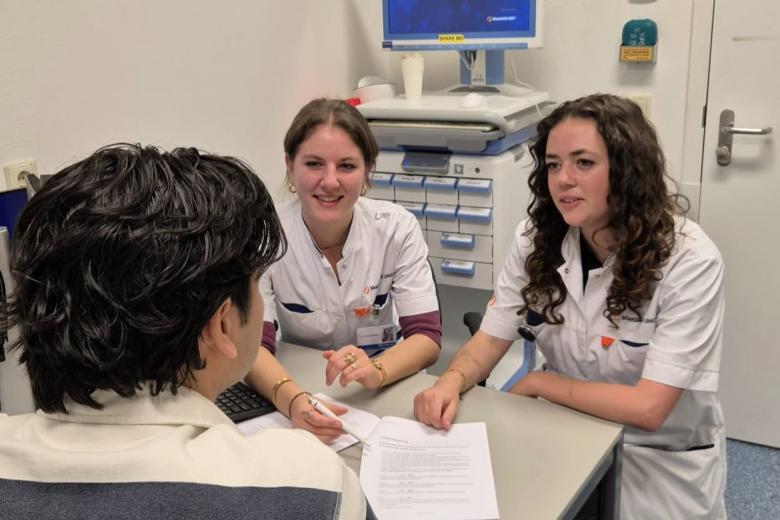Interview Paul Hofman, Professor of Forensic and Post-mortem Radiology
Paul Hofman, Professor of Forensic and Post-mortem Radiology: “We need more investigations into the cause of death”
In his inaugural lecture of 24 June, titled ‘Van beeldvorming tot sprekende beelden: forensische en klinische ontwikkelingen’ ('From imaging to convincing images'), Paul Hofman advocated a significant expansion of the research into deaths in the Netherlands. As of 1 October 2015, Hofman holds the position of Professor of Forensic and Post-mortem Radiology at the CAPHRI. Hofman furthermore posited that post-mortem radiology has a far broader field of application than merely in assisting the police and judiciary in criminal investigations, arguing that post-mortem radiological research into hospital deaths, for example, may contribute to better quality of care.
Hofman gained national recognition as a forensic radiologist for the involvement of this team in the criminal investigation into the MH-17 crash on 17 July 2014. The Forensic Radiology Unit (UFR) of the Maastricht UMC+ was called in to assist in the investigation and the identification of the victims. The UFR is regarded as a leading actor in this relatively new field. In forensic radiology, the deceased is studied using CT scans and, occasionally, MRI scans.
“I actually happened into the field quite naturally”, Hofman explains. He studied medicine in Nijmegen, trained as a radiologist in Maastricht and subsequently went on to specialise in neuroradiology, in which capacity he spends one day a week working at Kempenhaeghe, the epilepsy expertise centre located in Eindhoven.
In 2005, Hofman began collaborating with the police as a forensic radiologist and the partnership gradually gained an official status, with the Limburg Police Corps, the Public Prosecutor’s Office, GGD Zuid-Limburg and the MUMC+ all signing a petition in February 2013 for forensic radiology to be given a more formal structure. The UFR is currently a well-established body, made up of a team of seven radiologists, three forensic consultants and a number of lab technicians.
“Our forensic consultants are legally trained and are in charge of managing the radiologists and lab technicians, so the police receive the right information and reports can be used in criminal cases.”
The team now also compile reports based on scans provided by the Meander Medical Centre in Amersfoort.
In his inaugural lecture, Paul Hofman emphasised that the forensic radiology network should be expanded to four or five centres across the country. Hofman produced statistics to support his case, pointing to a global decrease in the number of obductions involving dissection of the thorax, abdomen, and, occasionally, the skull. In the Netherlands, less than three per cent of deceased persons receive such obductions. Frequently the cause of death is determined externally by autopsy.
“Investigation of those cases in the clinic, using scans or obduction, reveals a different cause of death in 25 per cent of cases. This research will be able to provide new insights for improvement of care.”
Outside the clinic, the cause of death for an average of 10,000 persons each year is established by a municipal coroner or forensic doctor by autopsy.
“There is no doubt that the correct cause of death is not always discovered. There may be more victims of crimes than we know of. Similarly, a person who died in a single-vehicle road traffic accident may appear to have a ruptured blood vessel in the brain. The deceased’s next of kin need that sort of information; it gives them peace of mind. It is also vital that Statistics Netherlands (CBS) log the reported cause of death and make policy based on those statistics.”
The great advantage of forensic and post-mortem radiology is that it is non-invasive in nature. “As such, the threshold for this type of examination is lower. Often it speaks for itself or can lead to a recommendation for obduction”, says Paul Hofman, who is pleased with his appointment. “I regard it as a token of recognition of my field.”
Watch the inaugural lecture
More information: forensischeradiologie.nl
Also read
-
Macrophages as key to treating liver fibrosis
Sabine Daemen is researching how certain macrophages can slow down fatty liver disease and fibrosis in order to develop new therapies.

-
Teacher Information Points at UM
UM faculties now host Teacher Information Points (TIPs) that offer local, “just-in-time” and on-demand support for teaching staff. The aim is simple: to provide help that is closely connected to day-to-day teaching practice.

-
More than a student job: five alumni about their unique role in groundbreaking vascular research
What is it like to take part in cutting-edge vascular research as a student, standing in the operating room, directly responsible for handling patient material? Five alumni of the Maastricht MAPEX student team share what they learned, the challenges they faced, and how this experience shaped their...
